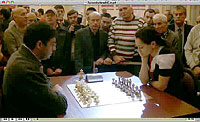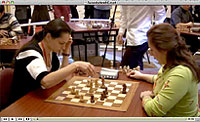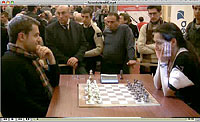Norway Chess Super Tournament 2013 Round 2: Sergey Karjakin Leads with Perfect Score; Carlsen, Anand Draw
Chess blog for latest chess news and chess trivia (c) Alexandra Kosteniuk, 2013
Hi everyone,
In the shadow of the game between Carlsen and Anand, the tournament had another entertaining round with three decided games. The game between Veselin Topalov and Teimor Radjabov true enough was neither entertaining nor decided, although it was a reasonable and solid performance from both players. In another complex Sicilian duel white held a slight initiative from the opening, and for some moves in the early middle game black and his queen appeared to be under pressure. Radjabov however played both faster and better in his second black game, forcing an exchange of the queens and later keeping balance on the clock as well as the board into a balanced knight and bishop endgame.
The game was drawn by mutual agreement after 40 moves. The position then was dead equal according to the computers, and both players looked fair enough satisfied although none of them smiled.
The important game between Levon Aronian and Hikaru Nakamura on the other hand soon accelerated from a slow start. Facing a Slav Defence with 1.d4 d5 2.c4 c6, Aronian immediately exchanged on d5 to enter a symmetric and often rather drawish exchange line. This however worked out well for the occasion, as Aronian could play out a home preparation, while Nakamura (probably feeling bored already) proved helpful to unbalance the position in favor of his opponent.
Having placed his knight on the strong c5 square white got a positional pressure, and the symmetry was broken as Nakamura felt forced to exchange the knight for his black squared bishop. After exchanging the other bishop at g6 white was clearly better, playing with an octopus knight on d6 against a disrupted pawn structure. Having exchanged the queens, Nakamura finally came up with some counterplay in the rooks and knight endgame, but it was too little and too late as he had first the much worse pawn structure and then was 1-2 pawns short.
Taking an unimportant pawn at h2 instead of protecting his vital e4-pawn at move 52 was a decisive mistake from black, but his position anyway was difficult at that point. Aronian kept his concentration up very well, methodically intervening with his rook on e7 and then advancing his queenside majority until black’s position went bankrupt just before 60 moves. Afterwards the rook and knight endgame became much less interesting, since white had an extra rook.
In short Nakamura is back on earth after hitting a wall, but still likely to fly again in some later rounds. While the very strong all-rounder Aronian – actually being unshared second with his 1.5/2 – has given himself a promising starting position.
The start racket of this tournament still is 23 year old Sergey Karjakin, today winning as black against Jon Ludvig Hammer. Karjakin was ahead on the clock and at least equal on the board after 15 moves in a Queens Indian, as black playing with a pair of bishops got sufficient counterplay against the white centre. Black’s position looked very promising after 25.— Nce5!?, creatively pseudo-sacrificing a knight to open up the position for the black bishops. Karjakin consequently continued by sacrificing his d5-pawn to open diagonals towards the white king.
Hi everyone,
Almost all spectators and cameras focused on the game Carlsen-Anand – which however became the second heavyweight positional draw in a row for both players. The rest of the tournament made another hard fought round, with no game lasting less than 40 moves and three games getting a well worthy winner. As both Nakamura and Svidler lost their first black game after winning their first white game, the still flying youngster Sergey Karjakin is leading alone with 2/2 after defeating Hammer as black. Below is the complete report by Hans Olav Lahlum via the official website.
While only about 20 spectators showed up for the historic start moment of this tournament, more than 200 spectators and several television channels were present today. Most of them obviously came to see the game in advance considered the most interesting one in this tournament: World Champion Viswanathan Anand playing black against his challenger Magnus Carlsen, in what might well be their only meeting before the World Championship match in November.
Carlsen played 1. e4 and Anand immediately replied 1.—c5, entering a Sicilian Moscow variation in which white play an early c4 and black reply e5. This leaves black with a backward pawn on d6, to be compensated by his active pieces. Having played complex Sicilian positions since well before Carlsen was born, Anand was twenty minutes ahead on the clock and close to equal on the board after 15 moves. Black got the pair of bishops, but controlling the d5 square with his knight white still held a slight edge in the early middle game.
It followed two tense hours of positional manoeuver and exchanges, with black slightly ahead on the clock and white closer to an advantage on the board. Black’s d6-pawn became more vulnerable after the queens were exchanged, and white for some moves around 25-30 looked better. The best chances to play for a win might have been 27.Rxc6! Rxc6 28.Ndc7, which probably could have won the d6-pawn as black’s plan with Rcc6 and Bg5 was a little overambitious. As the game went with 27.Rc3, black softened the press by exchanging one of his bishops for the d5 knight. Black had sound pieces all of the time, and got some counterplay in the c-file.
In the endgame with rook, knight and five pawns on each side, a draw was expected after 40 moves. Although looking all the more likely to fall asleep, Carlsen left a repetition of moves to play for a rook exchange. White eventually succeeded to exchange the rooks and to win a pawn in the knight endgame. Still it was insufficient for any winning chances, as black by realizing the d5-break was able to activate his king and exchange too many pawns. In the final position after 59 moves white formally was a knight up, but that did not help him much as Anand had voluntarily given up his knight to eliminate white’s two final pawns. No firework but still a heavyweight positional struggle between the World Champion and the highest rated player in chess history – leaving both still at a 50 % score, without any won or lost game in this tournament. Anand still can be fairly satisfied as he is now done with both the two top rated opponents, but both the chess stars must produce some more light during the remaining rounds if they want the first prize in this tournament.
While only about 20 spectators showed up for the historic start moment of this tournament, more than 200 spectators and several television channels were present today. Most of them obviously came to see the game in advance considered the most interesting one in this tournament: World Champion Viswanathan Anand playing black against his challenger Magnus Carlsen, in what might well be their only meeting before the World Championship match in November.
Carlsen played 1. e4 and Anand immediately replied 1.—c5, entering a Sicilian Moscow variation in which white play an early c4 and black reply e5. This leaves black with a backward pawn on d6, to be compensated by his active pieces. Having played complex Sicilian positions since well before Carlsen was born, Anand was twenty minutes ahead on the clock and close to equal on the board after 15 moves. Black got the pair of bishops, but controlling the d5 square with his knight white still held a slight edge in the early middle game.
It followed two tense hours of positional manoeuver and exchanges, with black slightly ahead on the clock and white closer to an advantage on the board. Black’s d6-pawn became more vulnerable after the queens were exchanged, and white for some moves around 25-30 looked better. The best chances to play for a win might have been 27.Rxc6! Rxc6 28.Ndc7, which probably could have won the d6-pawn as black’s plan with Rcc6 and Bg5 was a little overambitious. As the game went with 27.Rc3, black softened the press by exchanging one of his bishops for the d5 knight. Black had sound pieces all of the time, and got some counterplay in the c-file.
In the endgame with rook, knight and five pawns on each side, a draw was expected after 40 moves. Although looking all the more likely to fall asleep, Carlsen left a repetition of moves to play for a rook exchange. White eventually succeeded to exchange the rooks and to win a pawn in the knight endgame. Still it was insufficient for any winning chances, as black by realizing the d5-break was able to activate his king and exchange too many pawns. In the final position after 59 moves white formally was a knight up, but that did not help him much as Anand had voluntarily given up his knight to eliminate white’s two final pawns. No firework but still a heavyweight positional struggle between the World Champion and the highest rated player in chess history – leaving both still at a 50 % score, without any won or lost game in this tournament. Anand still can be fairly satisfied as he is now done with both the two top rated opponents, but both the chess stars must produce some more light during the remaining rounds if they want the first prize in this tournament.
In the shadow of the game between Carlsen and Anand, the tournament had another entertaining round with three decided games. The game between Veselin Topalov and Teimor Radjabov true enough was neither entertaining nor decided, although it was a reasonable and solid performance from both players. In another complex Sicilian duel white held a slight initiative from the opening, and for some moves in the early middle game black and his queen appeared to be under pressure. Radjabov however played both faster and better in his second black game, forcing an exchange of the queens and later keeping balance on the clock as well as the board into a balanced knight and bishop endgame.
The game was drawn by mutual agreement after 40 moves. The position then was dead equal according to the computers, and both players looked fair enough satisfied although none of them smiled.
The important game between Levon Aronian and Hikaru Nakamura on the other hand soon accelerated from a slow start. Facing a Slav Defence with 1.d4 d5 2.c4 c6, Aronian immediately exchanged on d5 to enter a symmetric and often rather drawish exchange line. This however worked out well for the occasion, as Aronian could play out a home preparation, while Nakamura (probably feeling bored already) proved helpful to unbalance the position in favor of his opponent.
Having placed his knight on the strong c5 square white got a positional pressure, and the symmetry was broken as Nakamura felt forced to exchange the knight for his black squared bishop. After exchanging the other bishop at g6 white was clearly better, playing with an octopus knight on d6 against a disrupted pawn structure. Having exchanged the queens, Nakamura finally came up with some counterplay in the rooks and knight endgame, but it was too little and too late as he had first the much worse pawn structure and then was 1-2 pawns short.
Taking an unimportant pawn at h2 instead of protecting his vital e4-pawn at move 52 was a decisive mistake from black, but his position anyway was difficult at that point. Aronian kept his concentration up very well, methodically intervening with his rook on e7 and then advancing his queenside majority until black’s position went bankrupt just before 60 moves. Afterwards the rook and knight endgame became much less interesting, since white had an extra rook.
In short Nakamura is back on earth after hitting a wall, but still likely to fly again in some later rounds. While the very strong all-rounder Aronian – actually being unshared second with his 1.5/2 – has given himself a promising starting position.
The start racket of this tournament still is 23 year old Sergey Karjakin, today winning as black against Jon Ludvig Hammer. Karjakin was ahead on the clock and at least equal on the board after 15 moves in a Queens Indian, as black playing with a pair of bishops got sufficient counterplay against the white centre. Black’s position looked very promising after 25.— Nce5!?, creatively pseudo-sacrificing a knight to open up the position for the black bishops. Karjakin consequently continued by sacrificing his d5-pawn to open diagonals towards the white king.
Hammer under pressure on the board and clock however still fought on stubbornly. Making his move 40 with six seconds left on the clock, the Norwegian appeared to have some chances with queen, rook, knight and four pawns versus queen, rook, bishop and four pawns. Exchanging the queens on e2 by some spectators was considered a mistake from Karjakin, as white still had the more exposed king. Black however had the better rook and the better minor piece in the resulting endgame, and reached a clear advantage when he got the necessary help to activate his king. Although white won back a kingside pawn, his position went lost with the vital a4-pawn a few moves later on. Hammer resigned after five hours and 54 moves – as he was unable to stop black’s passed a-pawn from promoting. Karjakin, now leading the main tournament alone with 2/2 after winning the blitz tournament, has had a truly brilliant start on this Norwegian chess adventure. Playing both confident and creative, the Russian so far looks like a strong candidate to become a 2800-player. Still of course he will get a hard time to defend this pole position against all the chess formula one cars now lining up behind him.
Peter Svidler although having won his game in the first round was not satisfied with his play: It turned out Hammer then was equal if not better from the opening after following an old analysis from Svidler, which the Russian himself was unable to remember during the game… Anyway things turned worse than that, as Svidler, like Nakamura, after winning with white in the first round soon got back on earth in the second.
Playing black in a Grünfeld instead of white in a Grünfeld, Svidler early had to start thinking following an unexpected 3.f3 from the young Chinese representative Hao Wang. Wang threw out 12 moves from an ambitious preparation, castling long and establishing a space advantage by playing both e4 and f4. Allowed to exchange white’s bishop on e3 for a knight, black’s position still looked healthy after 15 moves.
As black went astray with a probably dubious b5-Na6 plan, white coolly picked up the b5-pawn with a clear advantage. Wang took the long and safe road home when exchanging queens, but the remaining endgame with rook, knight and four pawns versus rook, bishop and three pawns was a mountain walk uphill for black. A long struggle still was expected after 50 moves, but it was all over after 63, as Svidler meanwhile made some more inaccuracies – while Wang instructively used his chance to activate the pieces while advancing his passed a-pawn.
Both players are in the main group at 50 % following this result. Both following the play and results so far can aspire for the top three as well as the bottom three places in this still very unpredictable field. We are looking forward for another hard fought round tomorrow, when Svidler will play white against Aronian and Wang black against Karjakin.
From Alexandra Kosteniuk's
www.chessblog.com
Also see her personal blog at
www.chessqueen.com
Don't miss Chess Queen™
YouTube Channel
Peter Svidler although having won his game in the first round was not satisfied with his play: It turned out Hammer then was equal if not better from the opening after following an old analysis from Svidler, which the Russian himself was unable to remember during the game… Anyway things turned worse than that, as Svidler, like Nakamura, after winning with white in the first round soon got back on earth in the second.
Playing black in a Grünfeld instead of white in a Grünfeld, Svidler early had to start thinking following an unexpected 3.f3 from the young Chinese representative Hao Wang. Wang threw out 12 moves from an ambitious preparation, castling long and establishing a space advantage by playing both e4 and f4. Allowed to exchange white’s bishop on e3 for a knight, black’s position still looked healthy after 15 moves.
As black went astray with a probably dubious b5-Na6 plan, white coolly picked up the b5-pawn with a clear advantage. Wang took the long and safe road home when exchanging queens, but the remaining endgame with rook, knight and four pawns versus rook, bishop and three pawns was a mountain walk uphill for black. A long struggle still was expected after 50 moves, but it was all over after 63, as Svidler meanwhile made some more inaccuracies – while Wang instructively used his chance to activate the pieces while advancing his passed a-pawn.
Both players are in the main group at 50 % following this result. Both following the play and results so far can aspire for the top three as well as the bottom three places in this still very unpredictable field. We are looking forward for another hard fought round tomorrow, when Svidler will play white against Aronian and Wang black against Karjakin.
From Alexandra Kosteniuk's
www.chessblog.com
Also see her personal blog at
www.chessqueen.com
Don't miss Chess Queen™
YouTube Channel
Labels: Magnus Carlsen, norway chess super tournament 2013, sergey karjakin, Viswanathan Anand





































1 Comments:
At May 11, 2013 at 8:10 AM , Palamède said...
Palamède said...
Interesting how Anand does not mind playing in Norway! :-)
Post a Comment
Note: Only a member of this blog may post a comment.
Subscribe to Post Comments [Atom]
<< Home